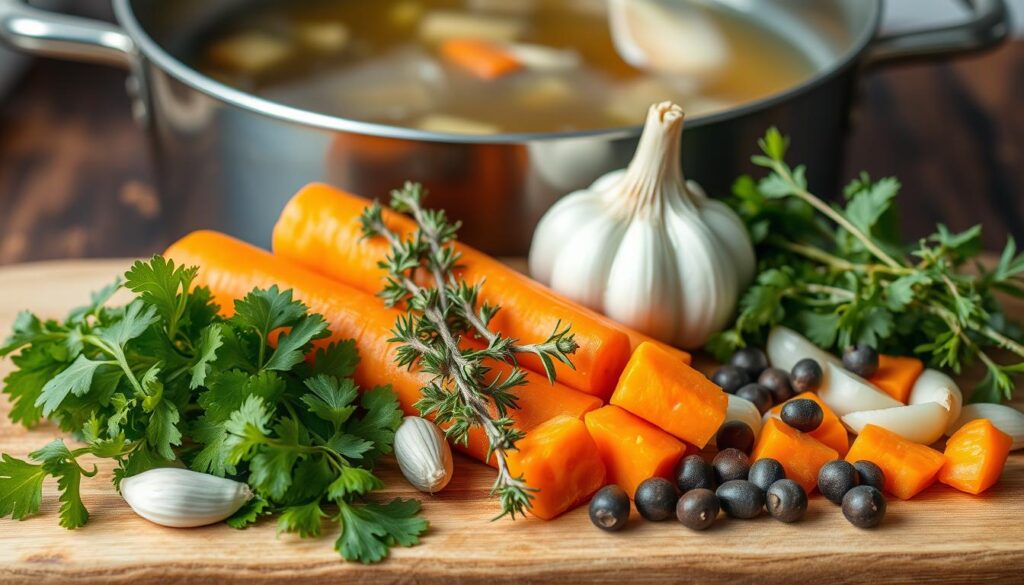The smell of homemade chicken broth is incredibly comforting. It brings back memories of family gatherings and delicious meals. Making chicken broth is a tradition that connects me to my roots.
In this guide, I’ll show you how to make your own chicken broth. It’s simple with just a few ingredients and some time. Homemade chicken broth is great for soups, stews, and sauces. It’s also healthier and cheaper than store-bought.
Table of Contents
Understanding the Basics of Homemade Broth
Creating delicious soups and stews starts with great broth. Homemade chicken broth adds a rich flavor to any dish. But what makes broth different from stock?
Difference Between Broth and Stock
The main difference between broth and stock is in their ingredients and how they’re made. Chicken broth is made by simmering meat and veggies in water. This makes a lighter, more versatile liquid. Chicken stock, on the other hand, is made by simmering chicken bones. This gives the broth a richer, more gelatinous texture.
Benefits of Making Your Own Broth
- Superior flavor: Homemade broths have a flavor that store-bought can’t match.
- Healthier ingredients: You control the ingredients, avoiding preservatives and additives.
- Cost savings: Making your own broth is cheaper, especially with leftover bones and trimmings.
Key Components for Success
To make the perfect chicken soup base, focus on these key components:
- High-quality chicken: Use fresh, organic, or free-range chicken for the best flavor.
- Aromatic vegetables: Carrots, celery, onions, and garlic add depth and complexity to the clear broth.
- Flavorful herbs and spices: Thyme, parsley, and peppercorns add herbal notes to your rich broth.
- Gentle simmering: Slow simmering extracts the most nutrients and flavor from the ingredients.
With these basics, you’re ready to make a homemade chicken broth that will enhance your dishes.
Essential Ingredients for Perfect Chicken Broth Recipe
Making a tasty and healthy chicken broth begins with the right ingredients. Start with a whole chicken, about 4 to 5 pounds. This size ensures the broth is rich and has a perfect balance of flavors.
You’ll also need some key aromatics to deepen the broth’s taste. These include:
- 5 whole peppercorns
- 4 sprigs of fresh thyme
- 2 garlic cloves
- 1 bay leaf
These herbs and spices add a subtle, earthy flavor. Using organic, free-range chicken makes the broth even more delicious.
Celery, carrots, and onions are also important. They help create the broth’s aromatic base. Make sure to use the right amount of each ingredient to get the flavors just right.
With these ingredients and the right technique, you’ll make a homemade chicken broth that’s better than any store-bought low-sodium broth. It will be full of flavor and nutrients.
Required Kitchen Equipment and Tools
To make the perfect slow cooker broth or instant pot broth, you need some key tools. First, a big 8-10 quart pot is essential. It must hold the chicken and all the ingredients.
Pot Selection Guide
Choosing the right pot is important. Look for one made of heavy-duty materials like stainless steel or enameled cast iron. These materials ensure even heat and prevent scorching during simmering.
Straining Equipment
After your broth is ready, you’ll need tools to strain it. A fine-mesh strainer or a cheesecloth-lined colander works well. They help you get a clear, sediment-free broth.
Storage Containers
After straining, store your broth in airtight containers or heavy-duty ziplock bags. This keeps it fresh and flavorful. You can use it right away or freeze it for later.
| Equipment | Recommended Features |
|---|---|
| Large Pot | 8-10 quarts, stainless steel or enameled cast iron |
| Strainer | Fine-mesh or cheesecloth-lined colander |
| Storage Containers | Airtight, heavy-duty ziplock bags |
Remember, while slow cookers and Instant Pots save time, a big pot on the stovetop is still the best for making homemade broth.
Step-by-Step Preparation Process
Making a tasty homemade chicken broth recipe is simple. Just follow a few easy steps. You’ll soon enjoy the warm, comforting taste of homemade chicken stock in your meals.
- Begin by putting a whole chicken, about 4 to 5 pounds, in a big pot or stockpot. Make sure it’s covered with cold water.
- Add your favorite aromatics like 5 whole peppercorns, 4 sprigs of fresh thyme, 2 smashed garlic cloves, and 1 bay leaf. They’ll add great flavor to your broth.
- Heat the pot to a boil, then lower the heat to low. Let it simmer for over an hour. Skim off any foam or impurities that come up.
After the chicken is cooked and the broth is rich, it’s time to remove the chicken and strain the broth. Use a mesh strainer or cheesecloth to get rid of solids. This leaves you with a clear, tasty liquid.
This chicken broth recipe is very versatile. You can keep it in the fridge for up to 4 days or freeze it for up to 3 months. It’s a great addition to your cooking, adding depth and warmth to soups, stews, and more.
Seasoning and Aromatics Guide
Improving your homemade chicken soup base starts with herbs, vegetables, and seasonings. Knowing the key elements for a rich broth can elevate your chicken stock. This makes your homemade soup stand out.
Herb Combinations
Thyme, parsley, and bay leaves are key for a flavorful chicken broth. They add earthy and woodsy notes that match the chicken well. Adding dill or fennel fronds later can bring freshness.
Traditional Vegetable Base
The mirepoix of carrots, celery, and onions is crucial for a great chicken soup base. These veggies add sweetness and depth. Garlic is also essential, bringing a savory flavor that holds everything together.
Seasoning Tips
When seasoning your chicken broth, start with a little sea salt and a few peppercorns. This lets you adjust later. Avoid strong veggies like turnips, as they can overpower the rich broth flavor.

Choosing the right herbs, vegetables, and seasonings makes a chicken soup base versatile and flavorful. This base is perfect for soups, stews, and comfort food classics.
Simmering Techniques and Cooking Time
Making the perfect slow cooker broth or instant pot broth requires careful simmering and cooking time. On the stovetop, simmer the broth gently for 1-4 hours. This low heat prevents clouding and lets flavors and nutrients fully develop.
If you prefer using a pressure cooker, cook the broth on high pressure for about 1 hour. A slow cooker, however, allows for a longer simmer of 4-8 hours. This results in a more intense flavor and better nutrient extraction.
The longer the broth simmers, the more flavorful it becomes. Chicken broth typically simmers for three to four hours to extract flavors and develop a rich texture. Be careful with vegetables like carrots, celery, and onions. Overcooking them can make the broth bitter.
| Cooking Method | Simmering Time | Key Benefits |
|---|---|---|
| Stovetop | 1-4 hours | Allows for gradual flavor development and nutrient extraction |
| Pressure Cooker | 1 hour | Faster cooking time, convenient for quick broth preparation |
| Slow Cooker | 4-8 hours | Longer simmering time results in more intense flavors and greater nutrient extraction |
Whether using the stovetop, pressure cooker, or slow cooker, simmer the broth gently and patiently. This allows the flavors to meld and nutrients to be fully extracted. With the right simmering technique and cooking time, you can make a flavorful and nourishing homemade broth that will enhance your cooking.
Straining and Cooling Methods
After your clear broth is perfectly simmered, it’s time to strain and cool it. This step is key for the best flavor and storage. It’s important to strain and cool correctly to get a clear chicken broth recipe for your dishes.
Achieving Clear Broth
To get a clear broth, strain it through a fine-mesh strainer or cheesecloth. This removes solids and impurities, leaving a clear liquid. Straining it multiple times can make it even clearer.
Proper Cooling Techniques
Cooling the broth quickly is vital to keep its flavor and stop bacteria growth. The best way is to cool it in an ice bath, stirring now and then. Or, you can split the broth into smaller parts for faster cooling. Once it’s room temperature, store it in the fridge or freezer.
| Cooling Method | Time | Benefits |
|---|---|---|
| Ice Bath | 30-45 minutes | Rapid cooling, preserves flavor |
| Smaller Portions | 15-30 minutes | Faster cooling, easier storage |
By using these straining and cooling methods, you’ll have a crystal-clear broth. It’s now ready to enjoy or use in your cooking.

Storage Solutions and Shelf Life
Keeping your homemade chicken stock or bone broth fresh is key. After you’ve simmered and strained it, think about how to store it right. This will help it last longer.
Use airtight containers or freezer-safe bags to store your cooled broth. Keep it in the fridge for up to 5 days or freeze for up to 3 months. Always remove any solid fat that forms on top before using.
When freezing, leave some space in the containers for expansion. Mark each container with the date to keep track of freshness. It’s smart to freeze in smaller portions, like 4-6 cups, for easier thawing and use.
| Storage Method | Shelf Life |
|---|---|
| Refrigerator | Up to 5 days |
| Freezer | Up to 3 months |
| Deep Freezer | Up to 1 year |
To thaw frozen homemade chicken stock, let it thaw in the fridge overnight or in cold water. Never thaw at room temperature or in hot water, as it can grow bacteria. Once thawed, use the broth within 4 hours.
By using these easy storage tips, you can enjoy your homemade chicken stock or bone broth for a long time. So, take your time and savor every sip!
Conclusion: Making the Most of Your Homemade Broth
Your homemade chicken broth is a versatile ingredient. It can make many dishes better. Use this chicken soup base as a base for soups, stews, and sauces. The leftover chicken can also be used in other recipes, making the most of your rotisserie chicken.
Think about making big batches of broth and freezing them in portions. This way, you can easily add homemade chicken stock to your meals all year. Try different herbs and vegetables to create unique flavors that you like.
Homemade broth tastes better than store-bought and is healthier too. It doesn’t have additives like MSG, carrageenan, or processed oils. Making your own chicken stock means you always have a healthy, versatile ingredient ready to improve your cooking.










